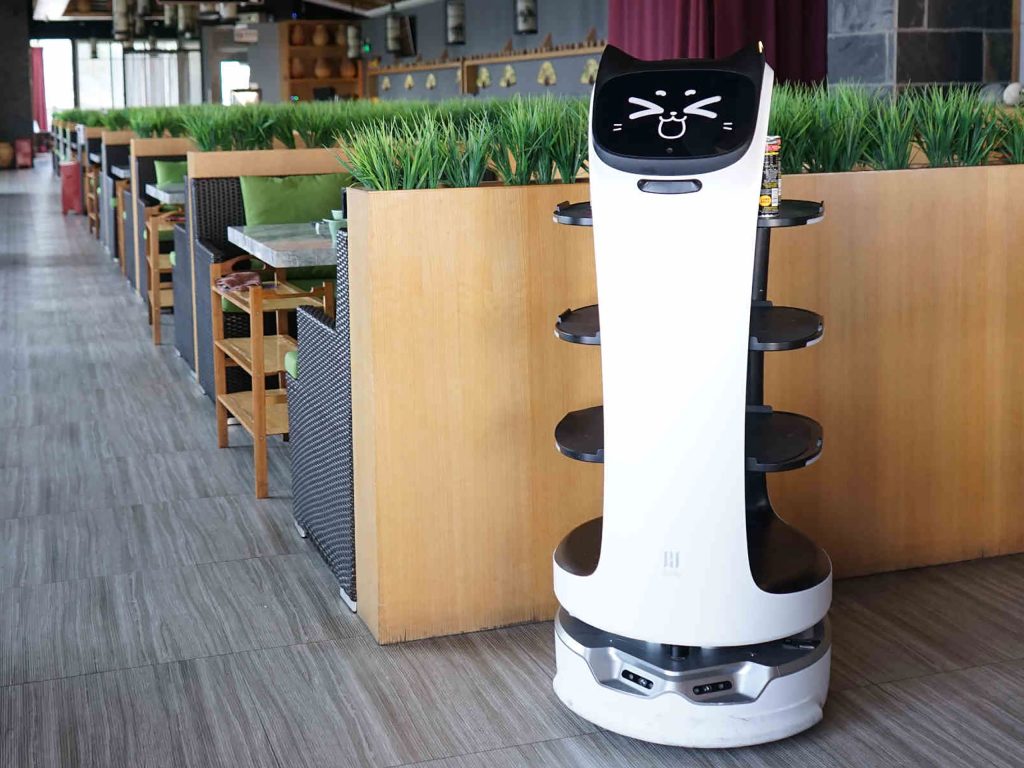
A shortage of skilled workers dominates the current gastronomy sector. At the same time, digitalization is advancing inexorably and opening up new markets. Will this lead to a revolution in personnel policy?
Since the restart of gastronomy, guests have returned, but there is a shortage of staff everywhere. This is also the case in the service sector: not a phenomenon of the post-lockdown period, but the shortage of skilled workers has become increasingly acute due to the far-reaching regulations that have been put in place to contain the coronavirus. The staffing gaps in many businesses are wide – even though there was less supply and more demand in July 2021; there were 20,356 unemployed people for every 8,489 vacancies in the Austrian hospitality industry. But people in the catering industry are still irreplaceable. Still? Companies around the world are working on advancing automation through high-tech robots in restaurant operations.
One of these is the Swiss marketing agency Precom Group AG, which specializes in digitalization in the catering sector. “Service robots could be an alternative to save restaurants from the worst,” says Managing Director Thomas Holenstein, explaining one way out of the staffing crisis. “Their acquisition costs are still high. But it’s worth it, because the artificial intelligence relieves their colleagues and works quickly and efficiently.” The advantages are obvious for Holenstein. They are already being used in the “Momoda” in Graz, for example.
Every human specialist rightly needs time to regenerate. Despite the statutory rest periods, even a skilled worker can be tired or simply not perform at full capacity. Not so a robot: it is just as fit at five in the morning as it is at half past one at night. He doesn't need a vacation, is never sick and never quits. It doesn't need statutory rest periods, and it doesn't know the meaning of listlessness or quitting. Once programmed, it only needs electricity to function.
Skilled workers in the hospitality industry often work in shifts. Whether early, late or, in the hotel industry, night shifts, nobody can do all this without interruption. A robot can! Ideally, it should not just replace one skilled worker, but more. It can easily take over several shifts in succession, which makes it extremely efficient. If used wisely, they can even increase productivity: in Shanghai, for example, there are two famous robots, Kona and Koya, which produce noodle dishes with extreme speed. They are also an attraction, drawing in guests. Other robots are also top performers: Non-humanoid service staff, for example, carried away up to four times more dishes than a human. All of this saves the employer considerable costs. The potentially high acquisition costs therefore quickly pay for themselves.
Catering is often no longer in demand among young people. Fewer trainees also means fewer skilled workers, which creates staff shortages.
This is where service robots come into their own! Because they are constantly learning and taking on ever more complex tasks. Their sensor technology is improving and their software is becoming increasingly sophisticated. This is what the future could look like: With one or more robots, perfect personnel planning is very easy. At most, there will be a lack of staff when the robot is undergoing maintenance.
All experts agree that pandemics will accompany us into the future. Social distancing remains just as important as perfect hygiene.
Robots as service staff are a good solution: they cannot infect anyone and still ensure that guests feel comfortable in the hotel or restaurant.
Every new employee needs a training period. The fact is that the instructor has double the work during this time, while the new employee works at half capacity. The workload is high during the induction phase. If there is also a high turnover of staff, such training periods are needed again and again.
Robots, on the other hand, only need to be programmed for their new tasks. Once this has been done, they immediately contribute their full manpower. This completely eliminates the training period. Work progresses more quickly because all employees can devote themselves fully to their work.
Several companies are now touting their innovations on the emerging market - even if the industry itself still seems to be skeptical. These include the burger robot from the American start-up Creator, which is supposed to make 400 burgers an hour, and the app-controlled serving robot from the start-up Cedar Robotics from Seattle. But drinks can also be served without human intervention: For example, by the coffee robot from Cafe X or the cocktail robot from The Tipsy Robot. The machines produce at least one drink every minute.
However, the robots are currently unable to respond flexibly to individual customer requests. The fear is that the savings could come at the expense of service quality, even if the machines always have a smile ready for the guests and promise safety in everyday catering work thanks to sensor, braking and balance technology. One thing is certain: nothing can replace personal contact and personal service. However, we must quickly come up with alternatives for skilled staff.

At first glance, Mind Set Win looks like a sports book—but it is actually a real coaching tool for anyone working in high-stress industries. Whether you’re a chef, hotel manager, or project manager, this book is all about concentration, self-management, and mental endurance.
The variety of perspectives is fascinating: from Max Verstappen to Lindsey Vonn, top athletes talk openly about pressure, failure, and mental routines. The accompanying exercises are suitable for everyday use, well-founded, and developed by professionals in psychology and coaching.
Particularly valuable are the chapters on focus and flow—a topic that is especially relevant in the hospitality world, where guest requests, team leadership, and self-motivation are daily concerns.
INFO
Mind Set Win—The mental techniques of top athletes and how we can use them for ourselves
Publisher: Benevento
240 pages
ISBN: 978-3-7109-0209-3
Price: €30.00 / CHF 40.90
It doesn’t take much to bring people together – sometimes all you need is tomatoes, pasta, and a pinch of history. In Pasta al Pomodoro, author Ilse Fischer focuses on a classic dish that is much more than just noodles with sauce: it is a symbol of community, memory, and flavor in its purest form.
The idea came about when Fischer tasted three-star chef Niko Romito’s signature dish, “Spaghetti e Pomodoro” – simple, clear, and yet stunningly deep. “Few ingredients, simple preparation, unique taste,” she recalls. And this experience became the starting point for a project that combines culinary art, emotion, and culture.
In 55 variations, she shows how differently and yet how closely connected this classic dish can be interpreted—from Italian nonnas to culinary greats such as Heinz Reitbauer, Andreas Caminada, Johann Lafer, Norbert Niederkofler, Rudi Obauer, and Tina Marcelli. Even artists and actors such as Philipp Hochmair and Walter Grüll contribute their personal versions.
INFO
Pasta al Pomodoro – 55 variations on the Italian classic
Author: Ilse Fischer
Photography: Ingolf Hatz
Foreword: Placido Domingo
Publisher: Christian Verlag GmbH
Length: 208 pages
ISBN: 978-3-95961-958-5
Price: €30.90 (D/A)
When Mediterranean lightness meets Andalusian temperament, the result is a menu that is more than just an arrangement of courses: it becomes a narrative about origins, freedom, and the longing for new perspectives. In December 2025, two-star chef Álvaro Salazar from VORO in Mallorca will take over as guest chef of the month at Restaurant Ikarus – and take Salzburg on a sensory journey between Andalusia and the Balearic Islands.


Since the restart of gastronomy, guests have returned, but there is a shortage of staff everywhere. This is also the case in the service sector: not a phenomenon of the post-lockdown period, but the shortage of skilled workers has become increasingly acute due to the far-reaching regulations that have been put in place to contain the coronavirus. The staffing gaps in many businesses are wide – even though there was less supply and more demand in July 2021; there were 20,356 unemployed people for every 8,489 vacancies in the Austrian hospitality industry. But people in the catering industry are still irreplaceable. Still? Companies around the world are working on advancing automation through high-tech robots in restaurant operations.
One of these is the Swiss marketing agency Precom Group AG, which specializes in digitalization in the catering sector. “Service robots could be an alternative to save restaurants from the worst,” says Managing Director Thomas Holenstein, explaining one way out of the staffing crisis. “Their acquisition costs are still high. But it’s worth it, because the artificial intelligence relieves their colleagues and works quickly and efficiently.” The advantages are obvious for Holenstein. They are already being used in the “Momoda” in Graz, for example.